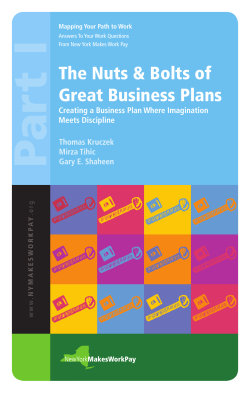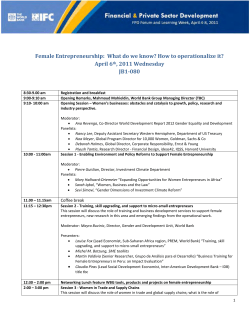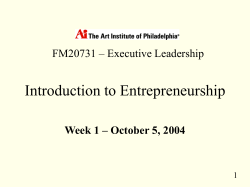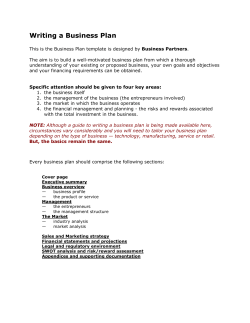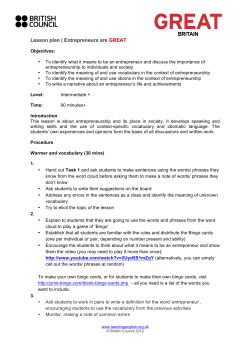
Chapter 5 Entrepreneurship
Chapter 5 Entrepreneurship Amazon.com, Inc. is an American e-commerce company based in Seattle, Washington. It was one of the first major companies to sell goods over the Internet. Founded by Jeff Bezos in 1994, and launched in 1995, Amazon.com began as an online bookstore but soon diversified its product lines by adding VHSs, DVDs, music CDs, MP3s, computer software, video games, electronics, apparel, furniture, food, toys, and more. Amazon has established separate websites in Canada, the United Kingdom, Germany, Austria, France, China, and Japan . It ships globally on selected products . It made its first annual profit in 2003. • Hotmail.com Sabeer Bhatia was born in Chandigarh, India in 1968. went to Stanford in 1989 to pursue his M.S. in Electrical Engineering. At Stanford, he was inspired by entrepreneurs such as Steve Jobs and Scott McNealy eventually deciding to become one himself. Instead of pursuing a Ph.D. after his Masters, he decided to join Apple in 1991. After a brief stint at Apple, Sabeer joined a startup company called Firepower Systems Inc, where he spent two years. In 1994, Sabeer started working on new ideas for the Internet and he teamed up with Jack Smith, a colleague from Apple Computer, Inc. Hotmail (Cont.) The two came up with the concept of a web-based database entitled Javasoft. While pursuing this idea, they subsequently realised the potential of a web-based e-mail system and thus decided to create one called HoTMaiL (the uppercase letters spelling out HTML - the language used to write the base of a webpage).In order to attract attention, the e-mail service was provided for free and revenue was obtained through the advertising on the website. Draper Fisher Ventures invested $300,000 on the project and the service was launched on July 4, 1996. In less than six months, the website attracted over 1 million subscribers. As the interest in the web-based email provider increased, Microsoft eventually took notice and on December 30, 1997, Hotmail was sold to Microsoft for a reported sum of $400 million. Hotmail (Cont.) http://www.businessweek.com/smallbiz/news/coladvice/book/bk990903.htm Entrepreneur Unveils New Tourist Spacecraft Sir Richard Branson Burt Rutan http://www.nytimes.com/2008/01/23/science/space/23cnd-spaceship.html?_r=1&oref=slogin Learning Goals 1. Explain the nature of entrepreneurship and the impact the environment has on it 2. Describe the competencies that contribute to entrepreneurs’ success 3. Outline the planning essentials for potential entrepreneurs 4. Describe the basic essentials of corporate entrepreneurship Entrepreneurs and External Factors Entrepreneurs create something for the purpose of gain while accepting the risk and uncertainty associated with their ventures. Entrepreneurs typically incorporate at least one of the following: – Something new – Something better – An underserved or new market – New delivery system or distribution channel Entrepreneurship: Its Meaning and Scope What is Entrepreneurship? The creation of an innovative organization for the purpose of economic gain or growth under conditions of risk or uncertainty Common Components of Entrepreneurship Something new Something better New delivery system or distribution channel Entering an underserved or new market How Does the Environment Affect Entrepreneurship? Open and free markets Deregulation Political climate Economic and technological conditions Support system Availability of capital and loans Tax rates and policies Support services: SBA, SBDCs, venture capital firms, chambers of commerce, etc. How Does the Environment Affect Entrepreneurship? Business incubation: a business support process that accelerates the successful development of start-up and fledging companies by providing entrepreneurs with an array of targeted resources and services Common features in business incubators Management and technical guidance Networking Rental space/flexible leases Shared business services and equipment Psychological and moral support Assistance in obtaining financing Small business—one that is independently owned and operated and which is not dominant in its field of operation. refer to anyone who owns a major equity stake in a company with fewer than 500 employees. SBA defines size by number of employees or dollars of sales, depending upon industry Small business firm may be entrepreneurial, depending upon its initiatives Are Family Businesses Entrepreneurial Firms? Family business: one owned and managed mostly by people who are related by blood and/or marriage May or may not be entrepreneurial 30% of family businesses survive to the second generation, 12% to the third generation, and 3% to the fourth and beyond Common Attributes of Successful Entrepreneurs (adapted from Figure 5.1) Technical Proficiency Attributes • Varies by Type of Business Started Personal Attributes • Need for Achievement • Desire for Independence • Self-Confidence • Self-Sacrifice Successful Entrepreneurs Managerial Competencies Attributes • Strategic Action • Planning and Administration • Teamwork • Communication • Self-Management Self management Need for achievement Desire for independence Self confidence Self sacrifice Communication Planning Teamwork Strategic and administration action Successful entrepreneurs Multicultural Specialized Knowledge Varies by type of business launched Importance of Self-Confidence and Optimism I think its’ important to see this clear path and not be discouraged when people throw stones at it, because they will. You will have to be willing to see the path, believe in it, and have the stamina and persistence to stick with it. You have to stand your ground and have confidence. Denise Divine Founder of Devine Foods Delivering products and services that are perceived as high quality and that are seen by its customers or clients as adding value Generating new customers or clients that expand revenue Maintaining financial control of the firm Developing or improving products and services on a regular basis Focusing marketing expenditures and developing customeroriented employees Establishing a strong commitment to ethical practices Planning and Administration Competency: Snapshot Do your homework prior to starting the business. Make sure the market truly needs your service or product. Finally, make sure you can differentiate your service or product from the competition in a way that is beneficial to the customer. Stay focused on your goals, but be flexible enough to modify your business plan to match what the market is truly asking for. As evidenced of why this is important: 75 percent of my firm’s revenue today is from services we did not offer in my original business plan. Daniel Driesenga Founder and CEO Driesenga & Associates Communication Competency Successful entrepreneurs score higher than 82 percent of the population on their ability to express support and encouragement Successful entrepreneurs succeed by helping other people—their employees, partners, investors, suppliers—become successful themselves Planning Essentials for Entrepreneurs Business Plan Snapshot Describes the basic idea that is the foundation for the start-up and outlines how that idea can be turned into reality “Someone once said: If you don’t know where you’re going, any road will take you there. You need to know exactly where you want to go, what route you’re going to take, when you will arrive and what you are to do upon arrival—no guesswork at all. You need to determine whether there is a demand for your service and, if so, what constitutes your market.” Don Doggett Management Counselor Counselors to America’s Small Business Business Plan: Essential Components I. Executive Summary What, how, why, where, and when must be summarized II. Business Description Component The name of the business The potential and uniqueness of the new venture (continued) Business Plan: Essential Components (cont’d) III. Marketing Component Convince investors that sales projections and competition can be met Identify target market, market position, market share, pricing strategy Evaluate all competition and state why and how you will be better than your competitors Identify advertising plans with cost estimates Business Plan: Essential Components (cont’d) IV. Location Component Describe the advantages of your location (zoning, tax laws, wage rates); list the production needs in terms of facilities (plant, storage, office space) and equipment (machinery, furnishings, supplies) Indicate proximity to your suppliers Business Plan: Essential Components (cont’d) V. Management Component Supply résumés of all key people in the management of your venture Describe the legal structure of your venture (sole proprietorship, partnership, or corporation) Give information on how and how much everyone is to be compensated Business Plan: Essential Components (cont’d) VI. Financial Component Describe the needed sources for your funds and the uses you intend for the money Develop an estimated budget, cash flow statement, and profit and loss statement Create stages of financing for purposes of allowing evaluation by investors at various points Business Plan: Essential Components (cont’d) VII. Potential Critical-Risks Component Any potentially unfavorable industry-wide trends, such as price cutting by competitors Design or manufacturing costs in excess of estimates Sales projections not achieved Product development schedule not met Provide some alternative courses of action Business Plan: Essential Components (cont’d) VIII. Milestone Schedule Component Develop a timetable or chart to demonstrate when each phase of the venture is to be completed IX. Appendix or Bibliography How to Start the Business Buy Strategy Start-up strategy Other options Franchise strategy Principle of Affordable Loss The conscious determination of the amount of resources (money, time, and effort) entrepreneurs are willing to commit to an idea, which, in turn, influences the choice of strategies and methods needed to generate early revenues Addresses tension between excessive analysis and quick action Finding Funds Venture capitalist Business incubators, government agencies (SBA) Business angel Entrepreneur, family, friends Private sector financial institutions Factors That Favor a Global Start-Up (adapted from Figure 5.2) Human Resources Are Dispersed Among Countries Foreign Financing is Better Target Customers Require an International Presence Global Start-Up Foreign Competition Will Quickly Enter the Market Domestic Market is Too Small to Support Expenses Domestic Inertia Could Impede Later Efforts to Internationalize Recommendations to Ensure a Successful Family Business Clear Job Explicit Hiring Criteria Responsibilities For Family Members And Authority Relationships Commitment to Resolving Conflicts Quickly Plan for Management Transitions Use of Outside Advisors/Directors Corporate Intrepreneurship What is Corporate Intrepreneurship? • Refers to the fostering of entrepreneurial behavior within established companies to product growth and profits. Essential for the survival of firms Who Is a Corporate Entrepreneur? Someone in an organization who champions turning new ideas into profitable realities Fostering Corporate Intrepreneurship Commitment from senior management Flexible organization design Appropriately designed control system Autonomy of the venture team Incentives and rewards for risk taking Competent and talented people who exhibit entrepreneurial behaviors and attitudes
© Copyright 2025

